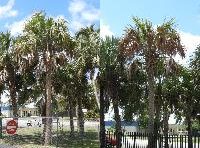Blog
Lethal Bronzing Disease
September 19th, 2019

PEST ALERT
LETHAL BRONZING DISEASE
Several species of palm trees in Florida have become afflicted with a fatal epidemic called Lethal Bronzing Disease, previously known as Phoenix Bronzing Disease – with no chance for recovery once infected.
Lethal Bronzing Disease is transmitted by tiny plant-hopper and leaf-hopper insects that move from plant to plant, feeding on the sap. The bacteria moves to the base of the palm once inside, and multiplies until the circulatory system is blocked. The blockage does not allow the palm to receive sufficient nutrients, causing it to die. As an infected palm dies, the fronds and central spear leaf turn from green to bronze (brown), and the palm is usually dead within six months. Any other insects that feed from the infected palm will pick up the disease and pass the bacteria to more palms, therefore, once infected, the tree needs to be removed.
According to IFAS, “Management of LBD involves removal of infected palms and preventative injection of antibiotics. Current data suggests that once palms start showing symptoms, the label rate for the antibiotic oxytetracycline-hydrochloride is not sufficient for symptom reversal. Because of this, upon symptom development and/or a positive test result, a palm is considered lost and should be removed immediately to reduce the amount of time this source of phytoplasma exists in the environment. The longer it is left, the higher probability that further spread will occur. Sampling healthy-looking palms around symptomatic palms can help get ahead of the disease because healthy-looking palms can also test positive. Even though no symptoms are present, those palms still need to be removed because there will not be sufficient time for the antibiotic to take effect before symptoms develop. Also, by testing healthy-looking palms, you can identify which palms are not infected and start preventative injections with the antibiotic… The disease is confirmed by laboratory analysis of tissue extracted from the trunk… Administer antibiotic injections to non-symptomatic susceptible species growing around removed palms. Inject oxytetracycline at 3 grams per palm (1 gram for small species like Christmas or pygmy date palms). Repeat injections every three months for at least two years.”
IFAS also states that “The disease can be difficult to recognize in the field, because nutritional problems (potassium deficiency, for example) and certain fungal diseases can look similar to the effects of the phytoplasma infection. … In taller Phoenix palms, it can be difficult to impossible to see the spear leaf. Typically, infected cabbage palms will have at least the bottom ⅓ of the canopy dead and bronzed brown, and a much paler dead spear leaf. A ring of leaves surrounding the spear leaf typically remains green for some time after the spear leaf dies. Eventually, all the leaves collapse and fall, leaving the stem erect.” …“The Lethal Bronzing Disease phytoplasma is limited to the sap of the palm and cannot survive outside a plant or insect; therefore, it cannot be mechanically transmitted (e.g., by pruning tools or infected roots touching new roots).”
In just over ten years, this problem has increased from a small infestation on Florida’s Gulf Coast to almost statewide. The rate of spread is becoming greater, with tens of thousands of palms already dead. The Sabal Palm, which is the official state tree of Florida, is especially vulnerable to LBD.
So far, Lethal Bronzing Disease has been found in the following species of palms:
- Christmas Palm
- Bismarck Palm
- Pindo Palm
- Carpentaria Palm
- Coconut Palm
- Chinese Fan Palm
- Canary Island Date Palm
- Edible Date Palm
- Pygmy Date Palm
- Wild Date Palm
- Fiji Fan Palm
- Buccaneer Palm
- Mexican Palmetto
- Cabbage Palm
- Queen Palm
- Chinese Windmill Palm
Information and photos provided by:
-
Plant Pathology Department, UF/IFAS Extension
-
Florida Department of Agriculture and Consumer Services, Division of Plant Industry
